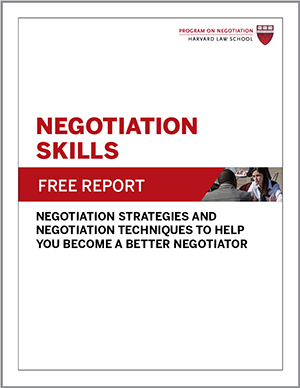
Should you make the first offer in a negotiation? Typically yes, abundant research on the anchoring bias suggests. What is anchoring in negotiation? In negotiations centered on price or another figure, the party who moves first typically benefits by “anchoring” the discussion that follows on her offer—even if the anchor is arbitrary. For example, the list price on a home tends to strongly anchor how potential buyers and their agents view the property and the counteroffers they extend.
The anchoring bias, or anchoring effect, is considered a “bias” because it distorts our judgment, especially when the bargaining zone is unclear. This knowledge of the anchoring bias in negotiation can help us make and respond to first offers more effectively.
Compatible Issues and the Anchoring Bias
When parties are negotiating multiple issues, a negotiator who identifies a so-called compatible issue when making the first offer loses the advantage of moving first, professor David D. Loschelder of Saarland University in Germany and his colleagues found in a 2014 study published in the journal Psychological Science. A compatible issue is one on which parties have the same preference, such as a recruiter and job candidate who both want the candidate to work in Chicago, not New York.
In one experiment, pairs of participants played CFOs negotiating the sale of a pharmaceutical plant from one company to the other. The participant who made the first offer came out ahead when the offer mentioned only a sale price for the plant.
However, when participants mentioned a compatible issue, namely the date on which the plant would be transferred, the first-offer advantage turned into a disadvantage. Why? Because those who learned that their preferences were compatible on this key issue sometimes pretended they were actually at odds on the issue and used it to extract concessions.
The lesson? To anchor effectively, before negotiating, try to identify high-priority issues on which you and the other party share the same preferences and then exclude these issues from your first offer.
Justifications and the Anchoring Bias
When presenting the first offer in a negotiation, you might assume that your counterpart will find the offer more persuasive if you back it up with a justification. A carefully reasoned argument is bound to be more compelling than just a cold, stark number, right?
In a 2011 article published in the Journal of Personality and Social Psychology, Tel Aviv University researchers Yossi Maaravi, Yoav Ganzach, and Asya Pazy conducted experiments to find out. In their studies, participants engaged in online-purchasing negotiations. Across the studies, the researchers found that when it was easy for negotiators to generate counterarguments, they were less receptive to the other side’s initial offer, or anchor.
In one experiment, for example, a seller presented participants (who were playing the role of buyer) with an opening offer for an apartment: “I ask $190,000 for the apartment.” Sometimes the offer was accompanied by a supporting argument, such as reference to a recent renovation; sometimes it was not. Buyers were asked to respond with a counteroffer. When sellers justified their first offers, buyers with easy access to the same facts about the apartment made significantly lower (tougher) counteroffers than did participants who had been distracted from these facts by an unrelated computer task. That is, the seller’s persuasion efforts were more successful when buyers had to work harder to remember the seller’s arguments. Thus, easy-to-counter arguments trigger a backlash in the form of simple counterarguments.
Using the Anchoring Bias to Improve Outcomes
The following four pieces of advice can help negotiators use the anchoring bias successfully and avoid being anchored themselves:
- Pause before persuading. When the other party can easily come up with counterarguments, your justification for an anchor may backfire. Negotiators may be more receptive to novel information you might provide, such as a newly lowered price or confidential data.
- Be ambitious and Though it generally pays to aim high to take advantage of the anchoring bias, try to avoid making an opening offer that could offend or stress your counterpart.
- Think beyond price. The anchoring bias typically refers to price anchoring, but you can think more broadly about how to anchor discussions in your favor. Asking the other party to agree to put a contentious issue on the table, for instance, should dramatically increase your odds of meeting your goals on that issue and may allow you to create value for both sides through tradeoffs. For example, a teacher’s union might open contract negotiations with a school district by raising the new issue of teacher training.
- Don’t avoid the challenge. Making the initial offer poses clear risks, yet research suggests that in many contexts, those who drop the first anchor do better than those who must try to overcome it.
How have you effectively used or avoided the anchoring bias in your negotiations?




